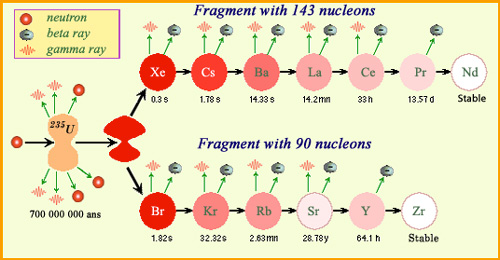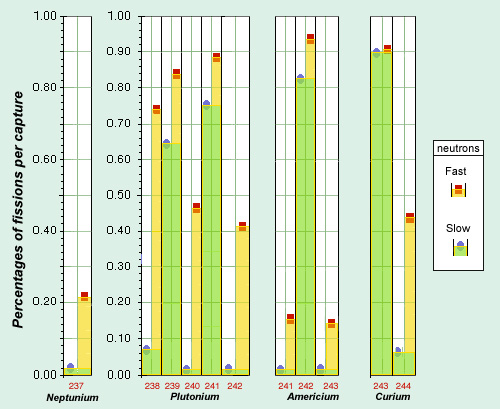Transforming radioactive nuclei to make them less troublesome…

Destruction of a heavy nucleus by fission
Fission is an excellent way of destroying very long-lived heavy nuclei. Here a fissile uranium-235 nucleus captures a neutron and splits into two highly radioactive fragments. At the end of a decay chain these become stable. The fragment with 143 nucleons takes about a fortnight to become stable, while the fragment with 90 nucleons takes around 30 years because of the strontium-90. Around 30 years is much less than the 700 million years that uranium-235 lives for. Isotopes of plutonium and minor actinides can be destroyed by fission.
© IN2P3
The incineration of household waste is part of the management of domestic waste. Can’t the same be done with radioactive waste? Once a difficult long-lived element has been isolated, can’t it be destroyed? To get rid of stubborn radioactive elements that live for hundreds of years or more, in principle all we have to do is change their nature, turn them into calmer, more stable nuclei.
Paradoxically, they may have to pass through states of being much more radioactive but more short-lived nuclei. To get rid of technetium-99, a fission product that lives for 210,000 years, we can transmute it to technetium-100 through the capture of a neutron. Technetium-100 then decays within a few minutes to a stable ruthenium nucleus. The radioactive decay process has been sped up (NB: in a reactor, this process uses a lot of neutrons).
that lives for 210,000 years, we can transmute it to technetium-100 through the capture of a neutron. Technetium-100 then decays within a few minutes to a stable ruthenium nucleus. The radioactive decay process has been sped up (NB: in a reactor, this process uses a lot of neutrons).
The long-lived radioelements  to be destroyed as a priority, because they are the most toxic, are heavy nuclei known as the minor actinides
to be destroyed as a priority, because they are the most toxic, are heavy nuclei known as the minor actinides – neptunium, americium, curium – which make up around 0.2% of spent fuel. They are fragile nuclei. If they are bombarded by neutrons with the right amount of energy, they undergo fission, which destroys them.
– neptunium, americium, curium – which make up around 0.2% of spent fuel. They are fragile nuclei. If they are bombarded by neutrons with the right amount of energy, they undergo fission, which destroys them.
Attempts will be made to destroy them by incorporating them into fuel for specialised reactors. Current reactors, which work with slow neutrons, are not very effective. But with fast neutrons, almost all the actinides become fissile, and therefore destructible. The shutdown in France in 1997 of the fast neutron reactor programme delayed the possibility of being able to burn these actinides. To reach that point again on an industrial scale will mean waiting for the arrival of the Generation IV reactors.

Transmutation of actinides: fast neutrons are most effective
Fast neutrons are effective at destroying heavy nuclei present in reactors, including those that are supposedly not fissile. Here the probability of fission of the isotopes of plutonium and the minor actinides using slow neutrons in a classic PWR reactor are compared with the probability using fast neutrons of an hybrid reactor. With fast neutrons, all the elements have a good chance of being eliminated by fission. The effectiveness of fast neutrons is due to the extra energy supplied by their kinetic energy, which makes the fission of fragile nuclei easier.
© IN2P3 (Source: ORNL-4628 PWR spectrum and energy amplifier)
Destroying troublesome nuclei is an arduous task. With the incineration of household waste, you are tackling atoms and molecules. It’s simple chemistry. Transforming nuclei one by one is much more difficult. You need a lot of neutrons, and there are a lot of nuclei to be transmuted!
The quantities that can be incinerated are limited. A 1 gigawatt reactor (3 GW power output) running 24 hours a day burning only actinides would destroy only 1.1 tonnes a year. This might seem disappointing at first glance, but reactors do not generate much of this waste (a PWR reactor generates 18 kg of minor actinides each year). Our incinerator reactor could in theory burn the actinides from 58 French reactors.
Rather than an alternative, incineration turns out to be more of a complement to disposal in deep repositories; it could never replace it. However, by reducing the volume and toxicity to be disposed of, incinerating the most troublesome waste would allow the specifications for long-term geological disposal facilities to be revised downwards. Transmutation is slated as the ultimate goal of research into waste.
Transmutation could not be used for high-activity waste already produced and conditioned.
Other articles on the subject « Waste strategies »
Slow disappearances
Trapping radioactivity until it disappears A scenario for the long-term future of the waste It wi[...]
Oklo : a natural reactor
Nature at work over the last two billion years It was noticed by chance in the 1970s that a urani[...]
Diluting radioactivity
A practice for elements with low levels of toxicity Management of radioactive waste generally foc[...]
Putting it out of reach
Containment and burial when it is not enough to wait Letting time do its work is not sufficient o[...]
Conditioning
Packages for trapping radioactivity… Conditioning means containing the radioactivity and im[...]
Temporary storages …
Storing: a useful but temporary solution Storing means tidying an object away with the intention [...]
Deep geological disposal
Ground-level and deep disposal: a definitive solution Deep disposal of the most radioactive waste[...]
Separating and sorting
Sorting radioactive waste has advantages As with household waste, sorting can prove really useful[...]
What to transmute?
Transmuting long-lived actinides and fission products Long-lived elements: actinides and fission [...]
Transmuting actinides
Attractive in principle, difficult in practice Destroying actinides using fission reactions is at[...]